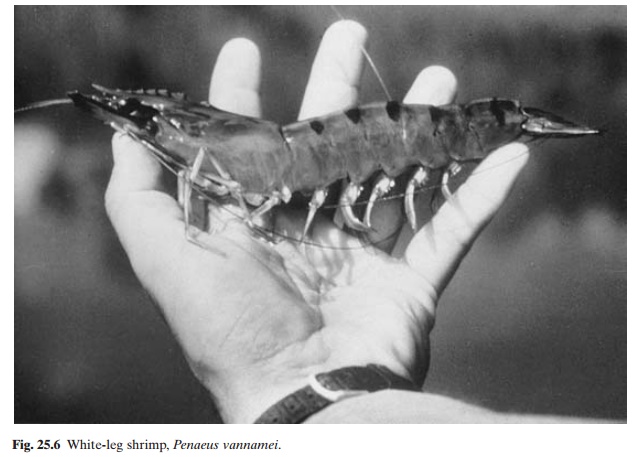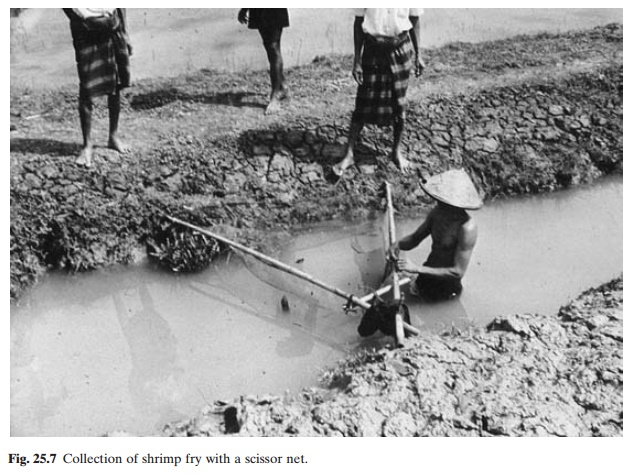Chapter: Aquaculture Principles and Practices: Shrimps and Prawns
Shrimp culture systems
Shrimp culture systems
Traditional and modern shrimp culture are carried out mainly in ponds. In traditional systems, where natural stocking was achieved through the intake of tidal water carrying large numbers of shrimp larvae, pond designs were simple and were meant to serve largely as trap ponds; many farmers releasing larvae directly into the rearing or production ponds. It is only in recent years that nursery ponds have been incorporated for growing larvae to an advanced juvenile stage, before transfer to production ponds.
With the adoption of techniques of controlled propagation, many shrimp farms now include hatchery units, together with nursery facilities. There is also greater specialization in the rearing of post-larvae or juveniles for sale to farmers for grow-out. Such nursery farms may maintain brood ponds, hatcheries and nurseries, together with facilities for growing natural food for larvae. When the larvae are collected from the wild, only nursery and live-food growing facilities may be maintained. Even though earth ponds are widely used, many farms adopting semi-intensive systems of culture have nurseries and even rearing ponds with cement concrete dikes.Macrobrachium ponds in Taiwan are often made of cement or bricks, or lined with plastic sheets, but sandy loam bottoms containing clay are preferred as they contribute to natural food production. Different kinds of shelters and artificial substrates are provided in ponds, including water plants, hollow bricks, framed nets, plastic pipes, styrofoam sheets, etc.
As mentioned earlier, traditional shrimp culture was necessarily a polyculture system because of an inability to control the composition of the seed stock. In coastal ponds or impoundments, shrimps formed only a small percentage of the harvest. Obviously the species combinations were not always compatible, and the culture procedures were not favourable for high survival rates for shrimps. Recent attempts at polyculture of milkfish and shrimps have shown the conflict of requirements between the species. For example, the shallow depths of milkfish ponds are not

favourable for shrimps and do not allow high stocking rates.There is considerable disparity in the time required to grow the species to marketable size. The transfer of stock from pond to pond, practised in milkfish culture, is not very easy for many species of shrimps, and every transfer generally results in injuries or deaths. In view of these practical problems, it is often preferable to adopt monoculture methods. Even combinations with other shrimp species do not seem to be very useful in many situations, in view of the differences in environmental requirements between species.
On the other hand polyculture of Macrobrachium with certain species of finfish isbelieved to be beneficial. Although not so common, M. rosenbergii is cultured together with Chinese carps (bighead and grass carp) in Taiwan and Malaysia. There are also reports of successful experimental and commercial culture with grey mullets, tilapia and red swamp crayfish, Procambarus clarkii.
Intensive systems of shrimp and prawn culture are generally practised in tank farms. Water in the tanks is frequently exchanged to maintain high oxygen levels and to discharge metabolic products. When the water exchange is low, heavy aeration is adopted to keep organic particles in suspension. These suspended particles serve as biological filters because of the dense colonies of nitrifying bacteria that grow on them. Circular tanks, up to 2000m2 surface area, with adequate water circulation and drainage facilities are in use. Raceway systems with a total exchange of water several times a day (sometimes built under greenhouses for better environmental control) have proved particularly efficient for certain species like P. stylirostris.
The traditional system of shrimp production in rice fields on the west coast of India is described. On the east coast of India, in the Gangetic delta, many farmers now raise crops of shrimps in rotation with rice.
Similar practices have developed in Bangladesh and in the Mekong delta area in Vietnam. After the shrimps have been harvested, the fields are stocked with carp during the rainy season, when the salinity in the fields is low.
Open-water stocking of shrimps carried out in Japan to enhance natural populations is referred. It is reported that at least 300 million post-larvae are released every year, and this is claimed to have formed the basis for new ‘sea ranching fisheries’ (Uno, 1985). Open-water stocking of the fresh-water prawn M. rosenbergii has been carried out in lakes and reservoirs in Thailand, and is reported to have become a source of food and revenue to local fishermen. Small-scale stocking of a river and of dams (reservoirs) has also been attempted in Taiwan (Chao, 1979).
Production of seed stock
Though hatchery techniques have been developed for the main species of shrimps farmed commercially, only a small proportion of the global requirement of seed-stock is presently produced in hatcheries. There are, of course, countries like Japan and Taiwan, where virtually all the required seed are produced in hatcheries. Other major shrimpculturing countries have depended on the collection of naturally occurring post-larvae and juveniles when available, rather than waiting for hatchery systems of production to be established. However, the collection of wild seed stock is not devoid of problems. There are considerable difficulties in sorting out the required species from the mixed collections, which may contain the larvae of slow-growing, undesirable species of shrimps and also of predatory or weed-fish. Secondly, there may be marked fluctuations in their availability. Thirdly, the shrimp fishermen in the area are more than likely to ascribe poor commercial catches of shrimps to the fishing of the larvae and juveniles for farming, and this can cause social conflicts.
Collection of wild seed stock
The traditional system of stocking ponds with post-larvae and fry brought in by incoming tidal water is still practised in many Asian countries. To eliminate unwanted fish larvae and fry and to estimate the number of shrimp post-larvae and fry stocked, an improved system of stocking has been proposed. This starts by filling nursery ponds with as many larvae and fry as possible by manipulation of the tidal flow. After about a month the nurseries are treated with teaseed cake (containing 10–15 per cent saponin) at a rate of 10–25ppm, to kill all the fish without affecting the shrimps. The shrimps can then be transferred to the rearing or production ponds.

Wild shrimp fry can be collected with different types of nets and lure lines. Push nets and scissor nets (fig. 25.7) are probably the most common equipment used. Lure lines, very much like the ones used for milkfish fry collection, are used to gather the fry, which are then removed using scoop nets. Fine-meshed bag nets (similar to the shooting nets used for carp spawn collection in India), with a receptacle at the cod-end, are also placed against tidal currents at high tides in creeks, canals or in sluice gates for catching incoming fry.The fry collect in the cod-end receptacle and are removed at frequent intervals.
The sorting of shrimp fry according to species requires considerable experience. The nature and location of pigmentation, body shape and mode of locomotion are some of the main identifying characters. ASEAN (1978) gives some distinguishing features for identification of the post-larvae and quotes a provisional key for P. indicus, P. semisulcatus and P. monodon.
Hatchery production of seed stock
Following on the early success of hatchery production of post-larval P. japonicus, considerable research effort has been directed towards the controlled maturation, spawning and larval rearing of a number of shrimps and of the fresh-water prawn M. rosenbergii. Though initial attempts were directed towards mass production with gravid females caught from the fishing grounds, success has since been achieved in the maturation and mating of shrimps in captivity.
Berried females of fresh-water prawns can be obtained from natural habitats or from pond farms. Alternatively, breeding stock maintained in tanks and aquaria can be mated after the mature female undergoes prenuptial moulting. Though the basic principles of seed-stock production for shrimps and the freshwater prawn are similar in many respects, there are some differences in detailed procedures and so they are summarized here separately. Detailed descriptions of seed-stock production can be found in McVey (1983), Huner and Brown (1985) and New and Singholka (1985)
Related Topics